2020 Kawasaki Ninja 650 Review - First Ride

Subtle revisions lead to an evolution of Kawi's upright sportbike
In the wake of declining sportbike sales, we’ve seen manufacturers drop supersport models or leave them untouched for years on end. For the more versatile, upright sporty bikes, the industry as a whole has not given up. For Honda and Kawasaki, models like the Ninja 650 and CBR650R offer sportbike looks with practical ergonomics and performance that riders can grow with. With both models receiving updates within the last year – including seriously stepping up their game in the looks department – these everyday sportbikes are even more enticing than ever.
2020 Kawasaki Ninja 650
| Engine | 17.0/20 |
| Suspension/Handling | 12.0/15 |
| Transmission/Clutch | 9.0/10 |
| Brakes | 8.0/10 |
| Instruments/Controls | 5.0/5 |
| Ergonomics/Comfort | 8.0/10 |
| Appearance/Quality | 9.0/10 |
| Desirability | 8.0/10 |
| Value | 9.0/10 |
| Overall Score | 85/100 |
For 2020, the Kawasaki Ninja 650 receives mostly aesthetic upgrades along with LED lighting, Dunlop Sportmax Roadsport 2 tires, and a TFT display featuring integrated Bluetooth connectivity through the Rideology app.
The new Ninja 650’s styling falls in line with its sporty siblings with a face nearly identical to the ZX-6R and Ninja 400. A redesigned windscreen integrates seamlessly into the new wider upper cowl and is said to be angled more upright to offer the rider more wind protection. During my ride on the freeway, the difference between sitting upright in a normal riding position versus fully tucked with my chinbar on the gas tank made zero difference in the amount of windblast I received to my helmet. Kawasaki offers a large accessory windscreen for those looking for more protection.
LED lighting throughout lends a premium touch, as do the smooth fairing surfaces which have been achieved by replacing fairing bolts with plastic hooks and tabs. Although the smooth continuous surfaces look nice, my thought was that they may be a bit of a pain to remove and reinstall, but I didn’t have a chance to undress the Ninja 650. So, I can’t be sure on that one. Hopefully, I’m wrong.
The new 4.3-inch TFT display is a first for the Japanese middleweights and was easily visible during our ride in varying light. The background can be adjusted from black to white and brightness adjusts automatically with ambient light. Plenty of information is available on the new screen such as trip data, average fuel consumption, gear indicator, coolant temp, voltage, service reminders, and Kawi’s ECO riding indicator among other data.
With Bluetooth connectivity, riders can now download the Rideology app which will allow them to take a look at all of those parameters (if paired when the bike was last on) before they go out to the garage in the morning to see if they need gas, etc. Connectivity through the Rideology app also includes telephone notifications which will show on the TFT screen, the ability to adjust some display settings, and a riding log that tracks route, distance, and time which can be shared and stored for playback. Unfortunately, on our ride full of quick stops for photo passes and the need to start/stop the ride log on the app while simultaneously making sure the phone was connected before restarting the log, the app didn’t work as well as I had hoped. A quick look at the app’s ride log post-ride also showed a line as the crow flies throughout the area we rode, and all of my GPS settings were on. The app may need a little work.
A welcome upgrade to the Ninja 650’s footing are the Dunlop Sportmax Roadsport 2 tires. I didn’t have a chance to ride the previous model with the old rubber, but I was told by everyone who had that the new Dunlops were a significant step up. An improvement I was grateful for since our ride included gravel-strewn roads, broken pavement, damp corners, tight twisty canyons, and freeways. The tires proved predictable and got everyone back to the hotel safe at the end of the day.
To some, the changes listed above for 2020 may not sound like much, but let’s not forget that when the 2017 Ninja 650 was released Kawasaki claimed it had shed 42(!) pounds, a substantial drop in weight that makes the bike easy to maneuver, be it through twisty roads or commuter traffic. This is a trait that’s just as apparent in the 2020 model as it was in 2017.
The Ninja 650’s 649cc Parallel Twin remains unchanged with Kawasaki reporting 67 hp at 8,000 rpm (via the EU site) and 48.5 lb. ft @ 6,500 rpm. The motor delivers nice mid-range power with the ability to be spun up when riding aggressively. Fueling is crisp, though driveline lash makes for some abrupt on/off throttle applications. The Kawasaki Air Management System’s (KAMS) radiator fan ducts channel hot air away from the rider to the ground which should make the Ninja 650 more pleasant to commute on during the warmer months of the year. At higher revs, some vibration can be noticed in the seat, but it’s nothing too intrusive.
The slick gearbox is ultra-positive allowing the rider to click through the gears snickety-split. The compact cassette-style transmission uses a slip and assist function to combat excessive engine braking caused by aggressive downshifts, ensuring the rear wheel doesn’t hop. Pull at the lever is also effortless guaranteeing one won’t tire during stop-and-go traffic.
Ergonomics, again, are carried over from previous years with the 2020 model receiving a slightly thicker rear seat for passenger comfort. The Ninja 650’s upright bars and standard footpeg placement make for a neutral seating position that left me mostly comfortable after riding all day. My only complaint is that the seat-to-footpeg measurement seems fairly short and if I was noticing at the end of the day with a 30-inch inseam, I’m sure taller riders were stretching their legs before I was.
Stopping power is provided by Nissin 2-piston calipers gripping 300mm petal-type discs up front, while a single Nissin caliper chomps on a single 220mm disc out back. No real complaints in the braking department. The Nissin components get things slowed down comfortably and efficiently. ABS and Non-ABS models are available from Kawasaki, with the latter offering slightly lower weight and price. That being said, we’d probably spend the extra $400 for ABS (and maybe in the racy KRT livery).
The 2020 Kawasaki Ninja 650’s suspension is one of the few things I feel could use some refinement. The thing is though, it’s just fine most of the time. When the pace picks up and the road isn’t perfectly smooth, you can be caught out. The fork works reasonably well and is even a bit stiff in the initial stroke but, once you blow through that on the brakes, being smooth is key to keeping things in check. The horizontal back-link KYB shock doesn’t feel totally matched to the front end and feels like it could use some more rebound damping. Alas, preload is all you have to work with.
We’re thankful that Kawasaki has managed to make the upgrades it has to the 2020 Ninja 650 without raising the price, non-ABS models start at $7,399. Now, we can only hope these sporty all-rounders are just what the market needs to get riders back to being interested in supersport bikes. Maybe a rider could have the Ninja 650 KRT for the streets and a ZX-6R in the garage for trackdays. With the newly revised model from Big Red being a serious contender in the category, maybe we should get these two together for a playdate soon.
2020 Kawasaki Ninja 650
+ Highs
- Proper good looks (especially in KRT garb)
- Agile AF
- Effortless positive transmission
– Sighs
- Seat to peg ratio
- Suspension could use some tweaks
- Not much wind protection
In Gear

Helmet: AGV Sportmodular Tricolore $850
Jacket: Dainese D-Air Misano $1,700
Gloves: Dainese 4-Stroke Evo $160
Pants: Dainese New Drake Air $260
Boots: Dainese Axial D1 $530
2020 Kawasaki Ninja 650 | |
|---|---|
| MSRP | $7,399 (non-ABS), $7,799 (ABS), $$7,999 (KRT) |
| Engine Type | 4-Stroke, Liquid-Cooled, DOHC, 4 Valve Cylinder Head, Parallel Twin |
| Capacity | 649cc |
| Bore/Stroke | 83.0 x 60.0 mm |
| Compression Ratio | 10.8:1 |
| Maximum Power | 67 hp at 8,000 rpm (Euro-spec claimed) |
| Maximum Torque | 48.5 lb. ft @ 6,500 rpm (claimed) |
| Fuel system | DFI® with Keihin 36mm Throttle Bodies (2) |
| Final drive | Sealed Chain |
| Transmission | 6-Speed with Positive Neutral Finder |
| Frame | High-Tensile Steel Trellis |
| Swingarm | Gull Wing Steel Pressed |
| Front Tire | 120/70-17 |
| Rear Tire | 160/60-17 |
| Front Suspension | 41mm Hydraulic Telescopic Fork with 4.9 in. of travel |
| Rear Suspension | Horizontal Back-link with Adjustable Preload with 5.1 in. of travel |
| Front Brake | Dual 300mm Petal Disc with 2-Piston Caliper |
| Rear Brake | Single 220mm Petal Disc |
| Seat Height | 31.1 inches |
| Wheelbase | 55.5 inches |
| Rake | 24° |
| Trail | 3.9 inches |
| Curb Weight | 419.0 / 423 4 (ABS) lbs. (claimed) |
| Fuel Tank Capacity | 4.0 Gallons |
| Colors | Metallic Spark Black, Pearl Blizzard White, KRT Lime Green/Ebony |

Ryan’s time in the motorcycle industry has revolved around sales and marketing prior to landing a gig at Motorcycle.com. An avid motorcyclist, interested in all shapes, sizes, and colors of motorized two-wheeled vehicles, Ryan brings a young, passionate enthusiasm to the digital pages of MO.
More by Ryan Adams



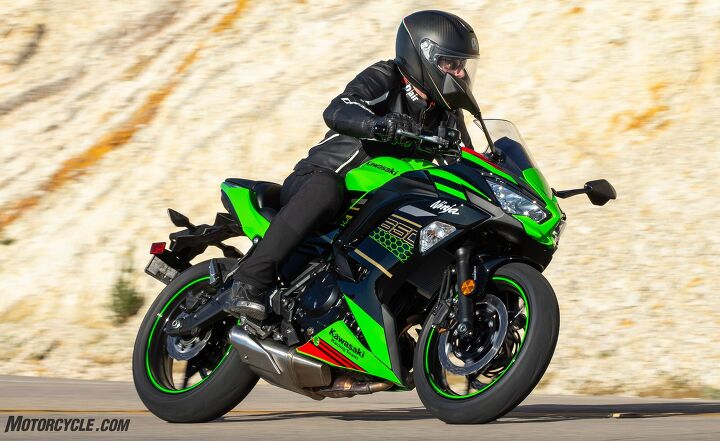
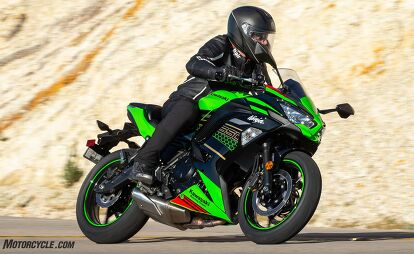
























































































































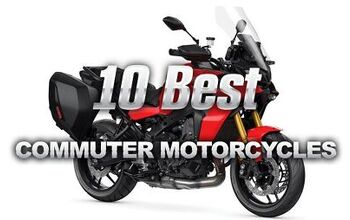




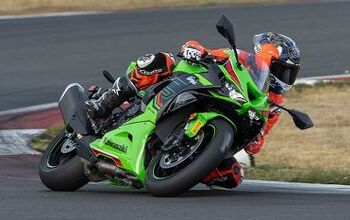
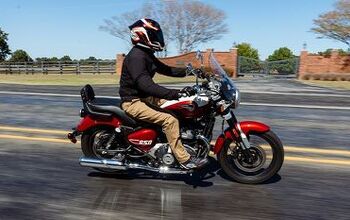










Comments
Join the conversation
Excellent review. Thorough and informative.
I'm glad the vibes aren't as bad as I've heard some say, but driveline lash is a bummer. That would probably spoil it for me.
Interesting in all the comments/reviews on here no one owns one.
My observations are that there is no issues with leg room. I am 6' and this is what you get with a sport bike. The updates in instrumentation are few but are good nonetheless. I don't need to connect a phone or have problems with sunlight on my 2018 model. Pretty much all the other gauge features were already there, just the look has changed. The fairing windshield I am not sure was an improvement as the previous model was adjustable as needed, though I have had no reason to move mine and upgrades are available and easy to swap out if you choose so. The LED headlights are nice but not necessarily needed, just a good upgrade as that is the way cars/bikes are going. During the summer I average around 65 mpg US at the pump, during regular daily work commutes in mixed riding, and have seen 67 when being frugal. For a non-super sport this bike is hard to beat!